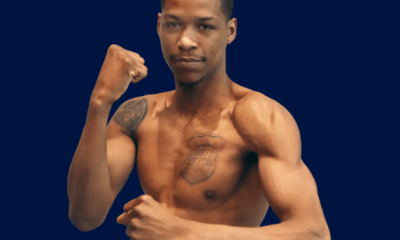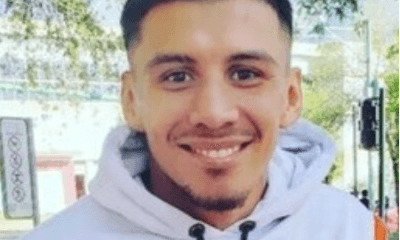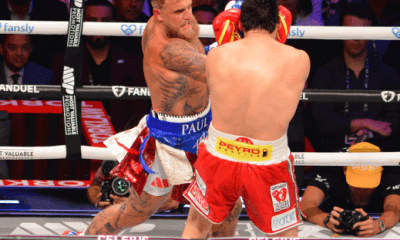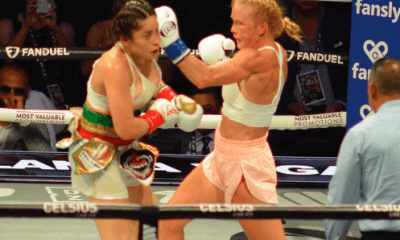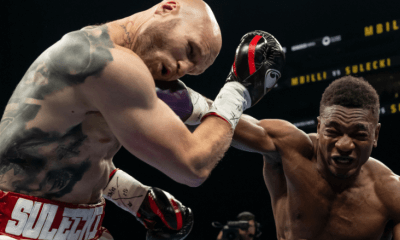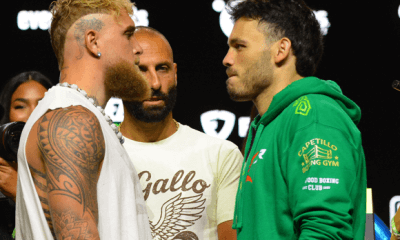Featured Articles
Fast Results From New York City: Andrade TKOs Akavov; Cano Shocks Linares
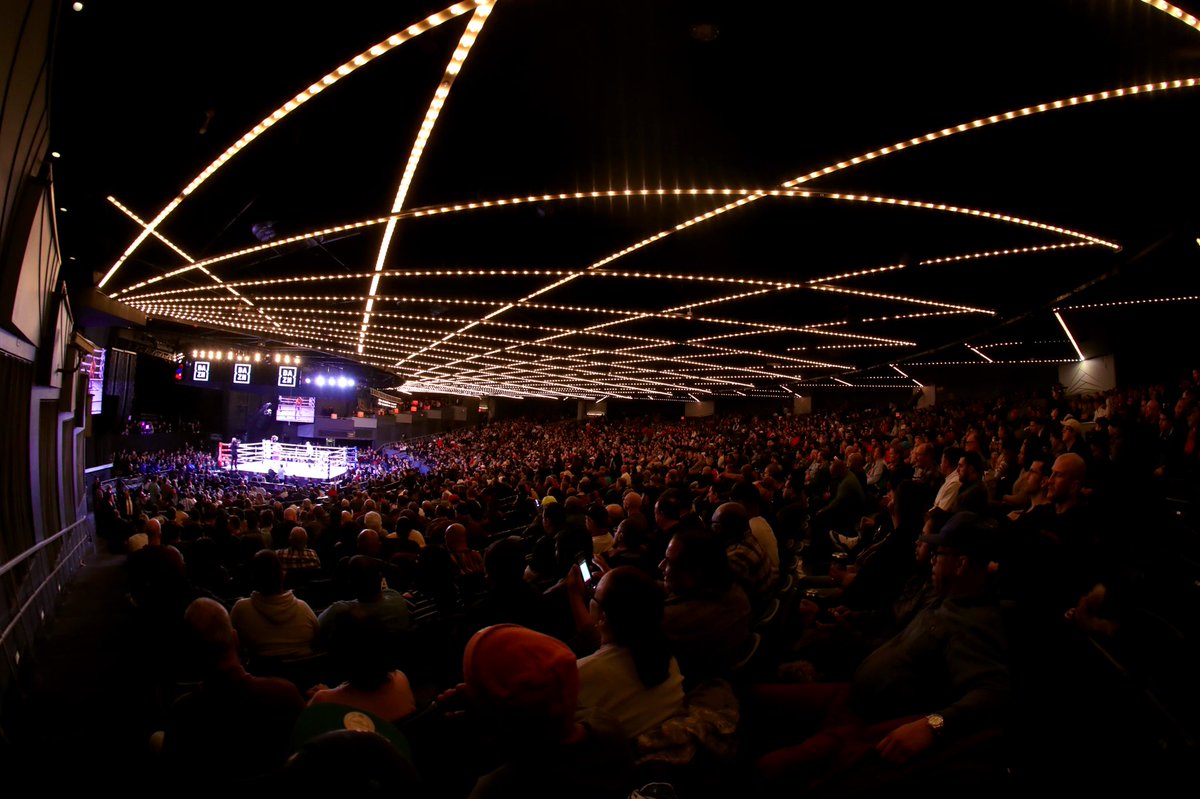
Eddie Hearn, the head of the boxing division of the U.K. sports conglomerate founded by his father, continued his invasion of the United States tonight with a nine-bout show in the Hulu Theater of Madison Square Garden. The featured bouts were live-streamed across the globe on DAZN and shown on SKY Sports Arena in the United Kingdom. Topping the bill was the WBO world middleweight title match between Demetrius Andrade and challenger Artur Akavov.
Andrade-Akavov
Andrade, a 2008 Olympian from Providence, R.I., successfully defended his title and advanced his record to 27-0 (17) with a 12th round stoppage of his game but outclassed Russian opponent. Akavov (19-3) was on his feet when the referee ordered a halt with 24 seconds remaining in the bout. Akavov, who ate a steady helping of jabs, wasn’t badly hurt but was hopelessly behind on the cards.
Cano-Linares
The co-feature, a junior welterweight attraction, produced a shocking upset when Mexico’s Pablo Cesar Cano (38-7-1) walked right through former three-division title-holder Jorge Linares (45-5), taking the globetrotting Venezuelan out in the very first round. Linares, who was considered a borderline Hall of Famer going in, was knocked to the canvas 20 seconds into the fight and was on the deck three times before the referee called a halt at the 2:45 mark.
Doheny
In the first defense of his IBF world 122-pound title, TJ Doheny was fed a softie in Yokohama schoolteacher Ryohei Takahashi. A massive favorite, Doheny (20-0, 15 KOs) was comfortably ahead on points when the referee intervened in round 11 to keep the Japanese import (16-4-1) from taking a worse beating. Doheny’s next match, according to Eddie Hearn, will be a unification fight against WBA counterpart Danny Roman.
Other Bouts
In a 10-round match contested at 140 pounds, Chris Algieri, briefly a title-holder in this weight division, scored his second win on the comeback trail with a unanimous decision over former sparring partner Daniel Gonzalez. The scores were 98-92, 97-93, and 96-94. Algieri (24-3) faded late and left the ring to a chorus of boos. Gonzalez slipped to 17-2-1.
Amanda Serrano made short work of her Austrian opponent, Eva Voraberger, taking her out in the opening round to gather in the vacant WBO world female super flyweight title. Serrano improved her ledger to 36-1-1 with her 27th knockout. She came in at 114 ½ pounds, having previously weighed as high as 138 1/2, and was seeking to become a title-holder in a seventh weight class.
Serrano knocked Voraberger (24-6) to her knees with a right-left combo and Voraberger, who was in severe pain, made no attempt rise. Forget those seven title belts; this young Brooklyn-based Puerto Rican can really fight.
In a welterweight match slated for six rounds, Julian Sosa, who has a large fan base in Brooklyn’s Mexican-American community, stopped Congolese import Deiumerci Nzau who retired on his stool after three frames. Sosa improves to 13-0-1 (5), Nzau falls to 11-7.
Heavyweight Nkosi Solomon evened his record at 1-1 and rebounded from a dismal performance in his pro debut with a 4-round unanimous decision over Rodriguez Cade (2-4). Solomon dropped his puffy opponent in the third round and won by scores of 40-35 on all three cards.
Staten Island’s Reshat Mati (3-0) needed only 66 seconds to turn back Ghana’s Benjamin Borteye (4-4). Mati came out smoking and scored a fast knockdown. Borteye beat the count but was on unsteady legs when the referee intervened. You will be hearing a lot more of the 20-year-old Mati, nicknamed the Albanian Bear, who was a teenage prodigy in multiple combat sports.
In the opening bout of the evening, a welterweight affair, Cornell Hines improved to 4-0 with a 4-round unanimous decision over Salt Lake City’s Farhad Fatulla (1-3).
Check out more boxing news on video at The Boxing Channel
To comment on this story in The Fight Forum, CLICK HERE
-

 Featured Articles3 weeks ago
Featured Articles3 weeks agoAvila Perspective, Chap. 330: Matchroom in New York plus the Latest on Canelo-Crawford
-

 Featured Articles1 week ago
Featured Articles1 week agoVito Mielnicki Jr Whitewashes Kamil Gardzielik Before the Home Folks in Newark
-
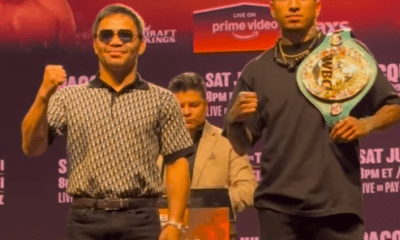
 Featured Articles4 weeks ago
Featured Articles4 weeks agoAvila Perspective, Chap 329: Pacquiao is Back, Fabio in England and More
-

 Featured Articles3 weeks ago
Featured Articles3 weeks agoOpetaia and Nakatani Crush Overmatched Foes, Capping Off a Wild Boxing Weekend
-

 Featured Articles2 weeks ago
Featured Articles2 weeks agoCatching Up with Clay Moyle Who Talks About His Massive Collection of Boxing Books
-

 Featured Articles3 weeks ago
Featured Articles3 weeks agoFabio Wardley Comes from Behind to KO Justis Huni
-

 Featured Articles1 week ago
Featured Articles1 week agoMore Medals for Hawaii’s Patricio Family at the USA Boxing Summer Festival
-
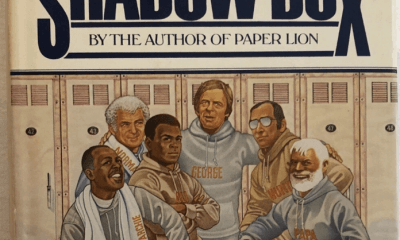
 Featured Articles4 weeks ago
Featured Articles4 weeks agoDelving into ‘Hoopla’ with Notes on Books by George Plimpton and Joyce Carol Oates

